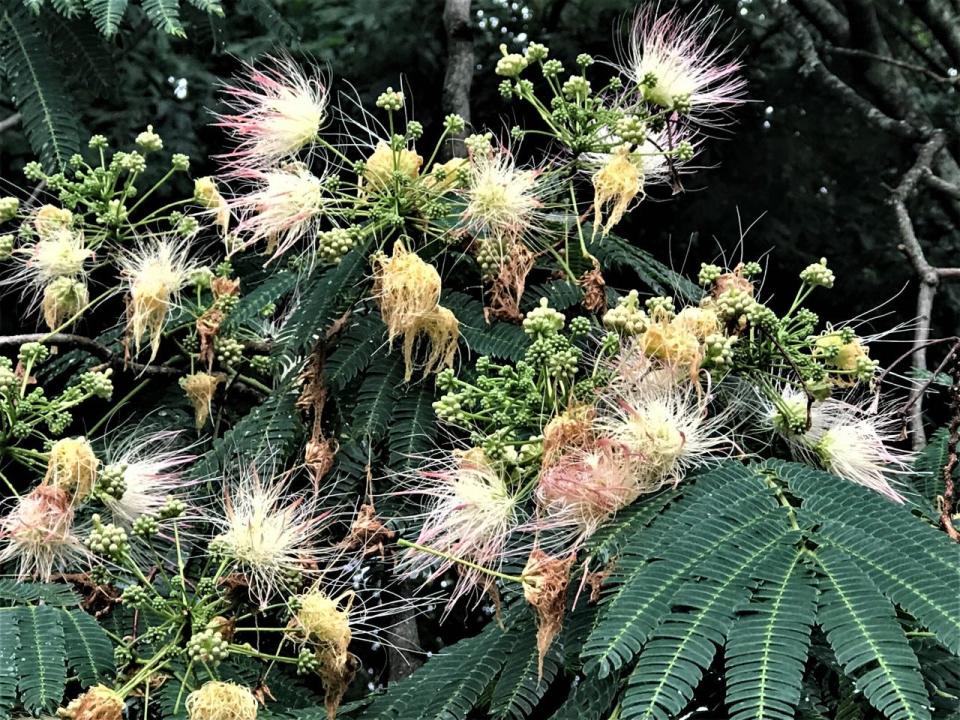Fragrant pink flowers make mimosa tree memorable| Mystery Plant

Summer 1962: It was the summer of “Wolverton Mountain” by Claude King (which was a good thing), Marilyn Monroe had just died (a sad thing), and America was soon to be gearing up for a missile crisis in the Caribbean (a very scary thing).
The summer highlight for this 11-year-old kid, though, had to be the week at Boy Scout camp, one county removed from home. I’ll never forget that week, and one of the memories from it were these trees, growing outside of the mess hall.
At that time, it was still deemed acceptable for 11-year-olds to climb trees, and that’s what I did with my little buddies.
The bark of the trees was pale gray and mostly smooth, a bit bumpy, and the lower limbs spread out pretty far: easy to get into the tree. I recall those funny “ferny” leaves, which always seemed to be folded up in the morning, right before they marched us to the mess hall for scrambled eggs.
The flowers, though, are what made mimosa (Albizia julibrissin) wonderful: in full bloom, with an amazingly sweet scent, and of course your nose would get tickled when you partook.
Easy addition: Jumping junipers: Sturdy and versatile plants popular for the home landscape
Gardening: Sunflower family member has medical uses and more | Mystery Plant
Poison ivy: Learn to recognize poison ivy and don't become its victim | Mystery Plant
It is a commonly seen plant, a smallish tree as it turns out usually, and rather short-lived, which has been planted widely in the southern United States and the Pacific Coast as an ornamental. Besides its intentional planting, mimosa has easily spread itself well beyond original plantings, and now has a reputation as a “weedy woody.”

This species (and many of its relatives) also exhibit what we call night “movements”: During the night, the leaves tend to droop, and all the leaflets will have folded themselves shut. The process is reversed when the sun comes up. The leaves are doubly compound; that is, each of the lateral leaflets is divided itself into 30-40 small divisions.
Those fragrant flowers, at first glance, are a bit misleading. The beautiful pink puffball, which most people regard as a flower, is actually 20 or 30 single flowers clustered together. Each of the flowers has very short, inconspicuous parts, that is, the sepals and the petals.
The showy pink part? Those are the 25 or so stamens with their long stalks, making that characteristic puffball effect.
In the middle of all those 20-30 tiny flowers will be one that makes the nectar, and it is that single flower that rewards hummingbirds and bees with a tasty lunch. The outer flowers within the puffball make no nectar: They are the ones that produce the fruits. The fruits, of course, are elongated, flattened pods, each with a bunch of hard little seeds inside.
This species is somewhat invasive, and is probably not a good plant next to a sidewalk or your pool, because of all the dropped flower puffballs and pods. Mimosa has a reputation for being messy, as some say. You might have to get a local Boy Scout to help clean up that stuff. Be prepared.

John Nelson is the retired curator of the A.C. Moore Herbarium at the University of South Carolina in Columbia, S.C. As a public service, the Herbarium offers free plant identifications. For more information, visit www.herbarium.org or email johnbnelson@sc.rr.com.
This article originally appeared on Tallahassee Democrat: Mystery Plant: Mimosa's pink, fragrant flowers perk up in daylight

